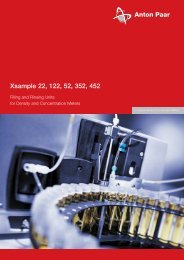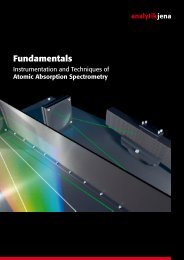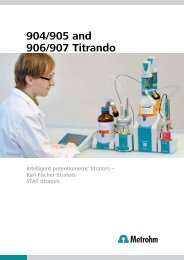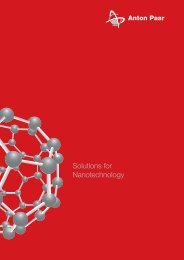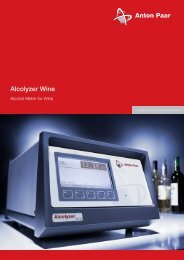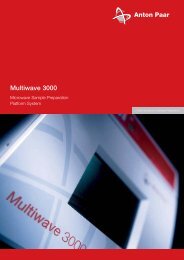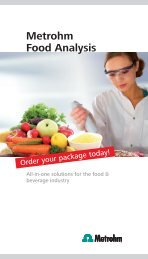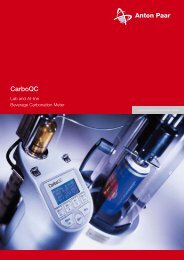EC-Twist - MEP Instruments
EC-Twist - MEP Instruments
EC-Twist - MEP Instruments
Create successful ePaper yourself
Turn your PDF publications into a flip-book with our unique Google optimized e-Paper software.
<strong>EC</strong>-<strong>Twist</strong><br />
Dynamic Mechanical Analyzer<br />
::: Intelligence in Rheometry
A New <strong>Twist</strong> on DMTA<br />
<strong>EC</strong>-<strong>Twist</strong> is a Dynamic Mechanical Analyzer<br />
for DMTA analysis on solids as well as liquids.<br />
The modular system performs measurements<br />
in torsion and extension and is the first DMTA<br />
solution that can also be used for shearrheological<br />
experiments – at unprecedented<br />
precision.<br />
Easy adaptation<br />
<strong>EC</strong>-<strong>Twist</strong> builds on your applications. Whatever your DMTA<br />
requirements are and will be in the future – <strong>EC</strong>-<strong>Twist</strong> is<br />
efficiently and comfortably adapted to meet your needs.<br />
The flexible application software and patented features<br />
such as Toolmaster TM , an automatic tool recognition and<br />
configuration system, make sure of this. Changing a film<br />
or solid bar fixture for a cone-plate measuring system is<br />
just as easy as integrating a new temperature device or<br />
connecting a CCD camera for sample visualization. You<br />
can use <strong>EC</strong>-<strong>Twist</strong> to analyze solutions, melts, solid bars,<br />
films, foils or reactive epoxy resins.<br />
High precision<br />
<strong>EC</strong>-<strong>Twist</strong> builds on technological innovation. The<br />
decoupling of sample pretension (stepper motor) and<br />
excitation (<strong>EC</strong> motor) considerably increases the system’s<br />
precision for solid bar measurements.<br />
<strong>EC</strong>-<strong>Twist</strong>’s peak performance is based on technological<br />
highlights such as the air-bearing-supported, synchronous<br />
<strong>EC</strong> motor, TruRate TM sample-adaptive motor control,<br />
TruStrain TM real-time position control or the patented<br />
normal force sensor integrated in the air bearing.<br />
Wide range<br />
Performed on highly diverse samples, DMTA analysis<br />
calls for full flexibility – ensured by a wealth of different<br />
measuring systems and temperature devices easily<br />
connected to <strong>EC</strong>-<strong>Twist</strong>. The instrument also performs<br />
DMTA tests in torsion or extension, as well as shear<br />
viscosity determination and extensional rheological tests.
Ready to Meet Your Requirements<br />
Convection temperature devices<br />
Four convection temperature devices are available,<br />
covering whichever temperature range you require.<br />
While the commonly used CTD 620 is optimized to<br />
cover almost 75 % of all applications, the patented<br />
CTD 180 is the only convection oven based on Peltier<br />
technology, enabling low-temperature measurements<br />
without the use of liquid nitrogen. The specialized<br />
CTD 600 and CTD 1000 temperature devices are<br />
mainly used for non-polymer samples such as glassor<br />
aluminum melts.<br />
Tribology System: friction and wear analysis of high-performance plastics<br />
CCD Camera Digital Eye<br />
Use the Digital Eye to record and display images or<br />
video sequences which are then optionally displayed<br />
directly in the diagram, assigned to the measuring<br />
points at which they were recorded.<br />
Measurement of additional properties<br />
Parallel-plate measuring system with thermo-melting polymer granules<br />
Due to <strong>EC</strong>-<strong>Twist</strong>’s Toolmaster TM function (automatic<br />
recognition and configuration of connected devices)<br />
and its high-precision flange, the instrument is easily<br />
and swiftly equipped with specialized devices like<br />
the Tribology System, for tribological analysis of<br />
high-performance plastics and lubricants, or optical<br />
and dielectrical systems for structure analysis, such<br />
as the SAXS or SALS system or the Dielectro-<br />
Rheological Device.
Evaporation Unit<br />
The Evaporation Unit (EVU) provides for constant<br />
temperature setting from -150 °C without temperature<br />
steps. Liquid nitrogen is continuously evaporated in<br />
an isolated reservoir and transferred to the measuring<br />
cell. This continuous evaporation without switch cycles<br />
facilitates temperature control at a level of precision that<br />
cannot be attained by means of valve control.<br />
Safety<br />
All outside surfaces of Anton Paar’s temperature devices are<br />
touch-proof up to their maximum temperature. The exhausts<br />
are designed with cooling mechanisms to ensure safe and<br />
comfortable use anytime and at any temperature.<br />
Shear<br />
rheology<br />
Extensional<br />
rheology<br />
DMTA<br />
torsion<br />
DMTA<br />
extension<br />
DMTA<br />
reaction<br />
Measuring system<br />
Polymer solutions<br />
Polymer melts<br />
Solid polymers<br />
Elastomers<br />
Reactive systems (epoxy resins)<br />
UV curing materials (Photo DMTA)<br />
Parallel plate<br />
Parallel plate, disposable<br />
Cone-plate, TruGap TM<br />
Solid rectangular fixture<br />
Universal extensional fixture<br />
Sentmanat extensional rheometer
DMTA in Torsion and Extension<br />
Relaxation steps during the softening process of<br />
a solid may become visible in the glass transition<br />
region. Various evaluation methods enable the<br />
quantification of a material’s transition from its solid<br />
to its rubber-elastic state. The melting point T m<br />
,<br />
the glass transition temperature T g<br />
, the secondary<br />
β- and γ-relaxations, the shear modulus at a given<br />
temperature – <strong>EC</strong>-<strong>Twist</strong> provides you with all these<br />
values at the push of a button.<br />
The following contains brief descriptions of the most<br />
essential <strong>EC</strong>-<strong>Twist</strong> test types for your consideration.<br />
DMTA in torsion<br />
One of <strong>EC</strong>-<strong>Twist</strong>’s main applications is the dynamic mechanical<br />
thermal analysis of thermoplastics, thermosets or elastomers in<br />
torsion. The measurement is performed in the destruction-free<br />
linear viscoelastic range using the Solid Rectangular Fixture<br />
SRF. The SRF enables determination of the shear moduli G’<br />
and G’’ and the loss or damping factor tan (δ) of solid bars.<br />
4 Oscillatory signal measured by the <strong>EC</strong> motor, without<br />
superposition of a pretension force<br />
4 Separate pretension and compensation of thermal<br />
expansion by the stepper motor<br />
4 Optimal measuring signal, especially in borderline<br />
areas – the extremely low temperatures below the glass<br />
temperature and the high temperatures close to the melting<br />
point<br />
4 Typical specimen dimensions (in mm): 40 x 10 x 1<br />
DMTA in extension<br />
The UXF Universal Extensional Fixture enables the<br />
measurement of the storage and loss modulus E’ and E’’<br />
as well as the damping factor tan (δ) of thin film sheets and<br />
fibers in the glass transition region. The system can be used<br />
to characterize multi-layer laminates as well as coating films.<br />
4 Modular design with various drums and QuickSnap fixture<br />
4 Measurement of E’, E’’ and tan (δ)<br />
4 Strain- or stress-controlled tests<br />
4 Typical specimen dimensions (in mm): 19 x 5 x 0.05<br />
4 For extensional melt rheology (in mm): 19 x 10 x 1<br />
Shrinkage and expansion measurement<br />
By applying a constant tensile stress or strain to a film or<br />
fiber, its shrinkage or expansion is measured depending on<br />
time and temperature. This method enables the practical<br />
evaluation of shrink films as well as investigations on film<br />
shrinkage by accidental heating (e.g. by solar radiation).<br />
Temperature sweep in torsion with glass transition<br />
Temperature sweep in extension with glass transition<br />
Film shrinkage and thermal expansion
DMTA on Reaction Kinetics<br />
The kinetics of reactive materials is investigated<br />
isothermally or by presetting a temperature ramp<br />
and a defined heating rate. The measurement is<br />
performed with disposable parallel-plate measuring<br />
systems (15 mm or smaller). A special evaluation<br />
macro in the application software evaluates the<br />
degree of cross-linkage based on the storage<br />
modulus and analyzes the sol-gel transition.<br />
One of the key features for precisely following<br />
reaction kinetics is the fast data acquisition based<br />
on <strong>EC</strong>-<strong>Twist</strong>’s TruStrain TM functionality. Typical<br />
sampling rates are 1 Hz as a quasi-standard or<br />
10 Hz for rapid curing processes.<br />
DMTA on reaction kinetics<br />
In the case of thermal cross-linkage, the liquid or<br />
two-component sample (resin and hardener) is heated and<br />
undergoes a viscosity reduction down to the softening point.<br />
From this point onwards, the cross-linkage reaction starts.<br />
Until its pot life the sample is still soft, but subsequently, i.e.<br />
at the sol-gel point, transforms into a gel-like state. Then it<br />
reaches its curing point and arrives at its final rigidity.<br />
a sample pressed into tablet shape. In a test like this, the<br />
sample passes through three phases. At first it is solid<br />
and unlinked. After the material’s fusion and melting at the<br />
melting point, its cross-linking starts, which leads to the<br />
material’s near-complete curing after it passes its curing<br />
point.<br />
Photo DMTA (UV curing)<br />
During the past few years, there has been rapidly growing<br />
interest in UV light curing of materials, a photochemical<br />
polymerization process. This technology has considerable<br />
practical and economic benefits. To measure materials’<br />
curing behavior, a powerful ultraviolet (UV) light source is<br />
connected to the measuring cell via a flexible light guide<br />
and controlled by the software.<br />
4 Optionally available with a built-in radiometer for<br />
calibration purposes<br />
4 Light source can be synchronized with rheological<br />
measuring profile using the application software<br />
Apart from “liquid-to-solid” curing procedures, <strong>EC</strong>-<strong>Twist</strong> also<br />
measures the cross-linkage reaction of an epoxy powder or<br />
Measuring modes offered by <strong>EC</strong>-<strong>Twist</strong><br />
Shear, continuous Shear, oscillatory Torsion, oscillatory<br />
Extension, continuous<br />
Extension, oscillatory<br />
Reaction kinetics of a curing resin<br />
Curing reaction of an epoxy resin with high<br />
concentration of filler<br />
UV cure and rate of cross-linkage
Melt Rheology<br />
<strong>EC</strong>-<strong>Twist</strong>’s range of measuring possibilities is<br />
not limited to solid samples. With cone-plate,<br />
TruGap TM or parallel-plate measuring systems<br />
with automatic gap control, polymers can also<br />
be measured as melts. Constant TruGap TM<br />
monitoring and control enables the use of<br />
cone-plate measuring systems to determine<br />
Mastercurves (Time-Temperature Superposition<br />
TTS) and measure temperature ramps – so<br />
when measuring polymer melts, you benefit<br />
from a constant shear rate in the measuring<br />
gap. Gap errors due to thermal expansion are<br />
no longer an issue.<br />
Shear rheology of melts<br />
A flow curve over a wide range of shear rates can also<br />
be generated from a Mastercurve using the Cox-Merz<br />
transformation. Regression models such as Carreau-<br />
Yasuda allow the calculation of important material<br />
parameters such as the relaxation time and power law<br />
index. The polymer's zero-shear viscosity is directly<br />
proportional to the molar mass.<br />
Transient time effects<br />
Stress relaxation tests provide information on<br />
time-dependent relaxation behavior after a defined<br />
deflection; creep tests on the other hand enable “longterm<br />
flow” measurements of melts, bars, films and fibers<br />
under a constant stress load.<br />
Time-Temperature Superposition<br />
The Time-Temperature Superposition enables<br />
the determination of Mastercurves at a<br />
given reference temperature. In this way, the<br />
frequency response and relaxation behavior<br />
can be determined over a range of more than<br />
10 decades.<br />
Extensional viscosity<br />
Extensional rheology is an excellent method<br />
for morphologically investigating elastomers<br />
or polymers. By measuring extensional<br />
viscosity under a preset constant strain rate,<br />
a distinction between linear and branched<br />
polymers is easily made.<br />
Further testing options<br />
In addition to the applications presented here,<br />
various further tests are available. <strong>EC</strong>-<strong>Twist</strong>’s<br />
application software offers diverse presets such<br />
as strain and amplitude, torsion, extension,<br />
compression (normal force), temperature<br />
and many more which can be combined in<br />
real time, enabling the exact simulation of<br />
application conditions.<br />
Flow curve converted from frequency<br />
sweep using Cox-Merz<br />
Mastercurve (Time-Temperature Superposition)<br />
Extensional viscosity of branched and<br />
linear polymer melts vs. time
Specifications<br />
Unit <strong>EC</strong>-<strong>Twist</strong> 302 <strong>EC</strong>-<strong>Twist</strong> 502<br />
Bearing - Air Air<br />
<strong>EC</strong> motor (brushless DC) with high-resolution optical encoder -<br />
Permanent torque (60 min), no signal drift -<br />
<strong>EC</strong> mode (controlled shear rate and shear stress)<br />
Maximum torque mNm 200 230<br />
Minimum torque, rotation nNm 10 10<br />
Minimum torque, oscillation nNm 2 2<br />
Torque resolution nNm 0.1 0.1<br />
Angular deflection, set value µrad 0.1 to ∞ 0.1 to ∞<br />
Angular deflection, resolution nrad 10 10<br />
Step rate, time constant ms 5 5<br />
Step strain, time constant ms 10 10<br />
Step time (rate, strain), 99 % of set value (all samples) ms 30 30<br />
Minimum angular velocity (1 rad/s 10 -9 10 -9<br />
Maximum angular velocity rad/s 314 314<br />
Minimum angular frequency (2 rad/s 10 -7 (3 10 -7 (3<br />
Maximum angular frequency rad/s 628 628<br />
Normal force range N 0.005 to 50 0.005 to 50<br />
Normal force resolution mN 0.5 0.5<br />
Dimensions mm 678 x 444 x 586 753 x 444 x 586<br />
Weight kg 42 47<br />
Toolmaster TM , measuring system -<br />
Toolmaster TM , measuring cell -<br />
QuickConnect for measuring systems, screwless -<br />
Electronic trimlock for the measuring system -<br />
Digital Eye, Software video option and camera -<br />
Virtually gradient-free (horizontal, vertical) temperature control -<br />
CoolPeltier TM , Peltier system with built-in cooling option requiring<br />
no additional accessories for counter-cooling<br />
°C -5 to 200 -5 to 200<br />
Peltier-based convection oven, does not require LN 2 for cooling °C -20 to 180 -20 to 180<br />
Actively Peltier-controlled hood, Peltier technology °C -40 to 200 -40 to 200<br />
Concentric-cylinder Peltier temperature control °C -30 to 200 -30 to 200<br />
Convection Temperature Devices (CTD) °C -150 to 1000 -150 to 1000<br />
Automatic gap control/setting, AGC/AGS -<br />
TruGap TM for in-place measurement and control of the gap -<br />
T-Ready TM -<br />
Direct strain, amplitude controller -<br />
Direct stress, amplitude controller -<br />
TruRate TM -<br />
TruStrain TM -<br />
Normal force and velocity profiles, tack, squeeze -<br />
Raw data (LAOS, waveform, ...) -<br />
1) Depending on measuring point duration and sampling time, practically any value is achieved<br />
2) Set frequencies below 10 -4 rad/s are of no practical relevance due to the measuring point<br />
duration > 1 day<br />
3) Theoretical value (duration per cycle = 2 years)<br />
Legend:<br />
optional
Photos: Croce & Wir<br />
Anton Paar ® GmbH<br />
Anton-Paar-Str. 20<br />
A-8054 Graz<br />
Austria - Europe<br />
Tel: +43 (0)316 257-0<br />
Fax: +43 (0)316 257-257<br />
E-mail: info@anton-paar.com<br />
Web: www.anton-paar.com<br />
<strong>Instruments</strong> for:<br />
Density & concentration<br />
measurement<br />
Rheometry<br />
Viscometry<br />
Sample preparation<br />
Microwave synthesis<br />
Colloid science<br />
X-ray structure analysis<br />
Refractometry<br />
Polarimetry<br />
High-precision temperature<br />
measurement<br />
Specifications<br />
subject to change<br />
without notice<br />
02/13 C92IP008EN-F


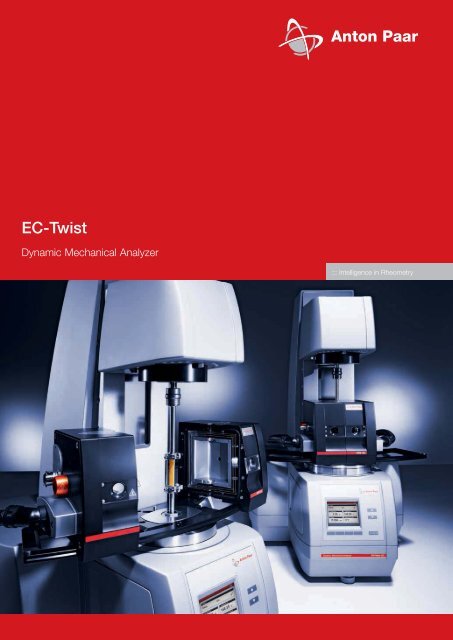
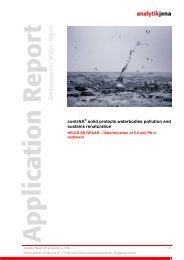
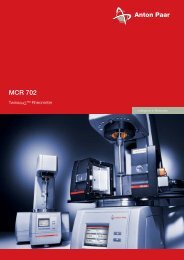
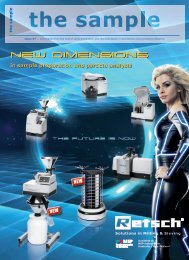
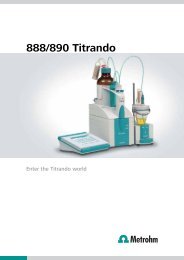
![Rice, size measurement of broken grains [pdf] - MEP Instruments](https://img.yumpu.com/46724497/1/184x260/rice-size-measurement-of-broken-grains-pdf-mep-instruments.jpg?quality=85)
